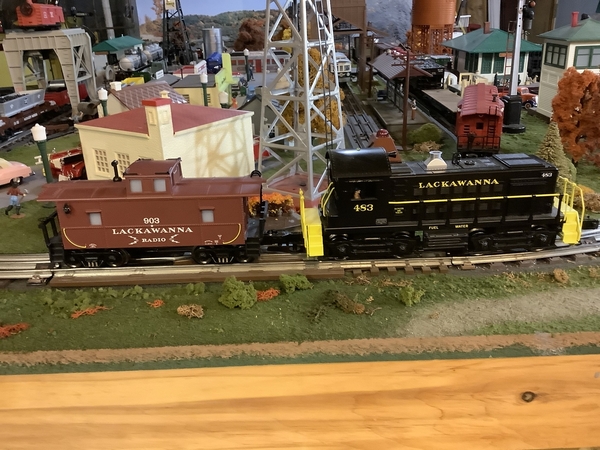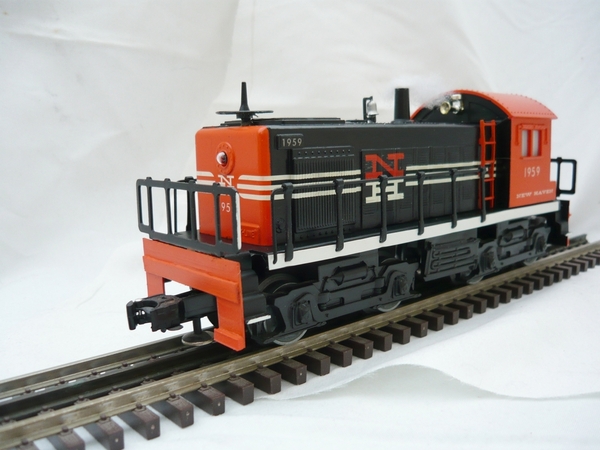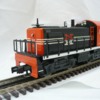Manny, the "K-Line by Lionel" was a branding of the products after the lawsuit between K-Line and Lionel, and K-Line's subsequent bankruptcy that left Sanda Kan almost $4 million dollars in the hole. The Sanda Kan factory facility continued to manufacture the rebranded K-Line products to be marketed and distributed by Lionel, so they are pretty much the same products as made and sold by K-Line.
The only real difference between the K-Line and later "K-Line by Lionel" S-2 switchers, was the addition of an electronic horn.
Now to address your other concerns. Most of the weights in the S-2 are over the rear truck. There is a smaller weight over the front truck underneath the circuit board. The first thing you want to check is if the wires running to the front truck through a hole in the sheet metal frame are pulled too tight... this will cause a derailment on curves of the front truck. As manufactured, the wires inside the loco are bundled together, so it might be necessary to loose these wires so that front truck swings left to right freely.
I spoke to engineering at K-Line about this front truck derailment issue and was told it was because you are running train that are too long, thus too heavy and this is causing the front truck derailment. This indeed might be true, but most folks buying a dual motored engine want to run longer trains.
My fix outside of loosening the wires, is to insert a small spring (I obtained a whole bunch from a old discarded computer keyboard that actually had springs beneath the key buttons) over the silver guide pin that comes up from the motor truck into a curved slit in the sheet metal frame. The spring goes between the top of the truck and the bottom of the sheet metal frame. Derailments ended.
K-Line never used fixed or dummy couplers on the S-2: They were all operating couplers on this model. Alco FA2's sold as double units had a fixed dummy coupler on the rear of the engine. Fixed couplers are not the source of derailments. It's is ability of the coupler to swing left to right enough to not bind and cause a derailment. When RMT reissued their revamped S-2, known as an S-4 "Bang" they made quite a few improvements, which I've written on previously. But one major drawback as the new diecast coupler used by RMT had a very stiff spring in it. If you were running a lighter weight car immediately behind the loco, it would inevitably derail. But there are some fixes for that too.
Still concerning derailments, it is also the shape of the coupler itself, and the open space within the closed knuckle coupler. On plastic trucks, it could also potentially be plastic flashing on the knuckle from the injection molding process. Sometimes you have to do a little filing to remove flashing and/or to open the space within the closed coupler just a little bit.
All the trucks and coupler assemblies made by the various companies are basically the same, yet they are all subtly different. Parts from one company, while appearing similar, may not work in another brand of trains without some tinkering.
Hope this all helps. Manny, you seem to have a lot of troubles with your trains that for the most part, I don't have. But I've also accepted since I'm buying lower cost trains, that I might have to make some alterations to run them the way I wish to. I've also always had small layouts with track configurations that are basically no-no's, like "S" curves, turnouts on curves, turnouts placed directly after a curve. So I make some alterations. But the pleasure is I haven't had a derailment in many years, outside of my own error, like forgetting to throw a turnout. Running trains for me is fun, not frustration.
But yes, I also did have problems with my RMT "Beep" that were very frustrating, since at that time I'd seen a video (now gone) on YouTube of a RMT Beep running flawlessly in and out of Lionel 027 turnouts. I messed around with that engine, trying all kinds of experiments and could never get it to run even remotely well through 027 turnouts. I ended up kitbashing a Lionel Industrial Switcher frame for it, and making alterations to the RMT Beep shell, BUT now it runs just great!









